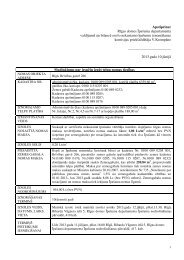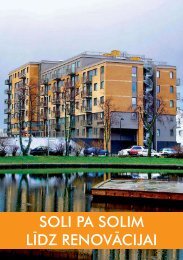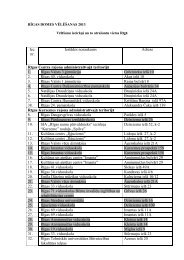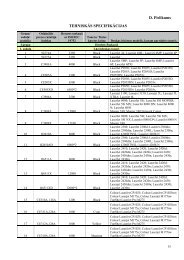Riga - European Capital of Culture 2014 candidate
Riga - European Capital of Culture 2014 candidate
Riga - European Capital of Culture 2014 candidate
- No tags were found...
You also want an ePaper? Increase the reach of your titles
YUMPU automatically turns print PDFs into web optimized ePapers that Google loves.
medieval monumental architecture constructions in the Baltic States. In the 17 th century,the church’s tower construction, at 64.5 metres high, was at its time the highest woodconstruction tower in Europe. In 1721, the church tower was hit by lightning and burntdown. By order <strong>of</strong> Russian Tsar Peter the Great, who at that time was in <strong>Riga</strong> and tookpart in extinguishing the fire, the tower was renewed in its previous form and then the totalheight <strong>of</strong> the tower was 120.7 metres. St. Peter’s Church was once again ravaged duringthe 2 nd World War and the tower renovation works were completed in 1973. Internal restoration<strong>of</strong> the church was completed in 1984. The wide church hall is used not only forreligious services but also for concerts, art exhibitions and displays <strong>of</strong> architectural andurban construction competitions.Small GuildThe Small Guild, built in 1866, is located in the very heart <strong>of</strong> <strong>Riga</strong> Old Town, next to Liv Square.The particularly opulent interior <strong>of</strong> the Small Guild was improved and embellished in 1888,during the time <strong>of</strong> longstanding Guild Elder Friedrich Brunstermann, when the coat <strong>of</strong> arms <strong>of</strong>the Small Guild was placed in the facade’s cornice opposite Meistaru Street, and the entrancehall, vestibule and hallway floors were laid in a terraco mosaic. The work was carried out byItalian craftsmen sent by the company Johann Odorico from Frankfurt am Main. Colouredstained glass was inserted into all the building windows in which the portraits <strong>of</strong> the craftelders and traditional clothes from earlier centuries are reflected with photographic precision.House <strong>of</strong> BlackheadsHouse <strong>of</strong> BlackheadsThe House <strong>of</strong> Blackheads, initially called the New House, was built in 1334, built as aplace for meetings and feasts for <strong>Riga</strong>’s public organisations. But in the 17 th century, itsonly inhabitants became the fun-loving and enterprising brotherhood <strong>of</strong> foreign merchants– the Brotherhood <strong>of</strong> Blackheads. One <strong>of</strong> many patrons <strong>of</strong> the brotherhood wasSaint Mauritius, a leader <strong>of</strong> the Roman Legion who died a martyr’s death – his head wascut <strong>of</strong>f, therefore the image <strong>of</strong> a Moor’s head became the Blackheads’ sign <strong>of</strong> recognitionand symbol, and was also depicted in the Brotherhood’s coat <strong>of</strong> arms. The building,known as the most resplendent jewel <strong>of</strong> <strong>Riga</strong>, just like the Town Hall, turned into ruinsduring the 2 nd World War. In 1991, in honour <strong>of</strong> <strong>Riga</strong>’s 800 th anniversary, the building wasbuilt anew by the City <strong>of</strong> <strong>Riga</strong> on its old foundations. A sculpture <strong>of</strong> Roland, the symbol<strong>of</strong> medieval Hanseatic free towns, was erected next to the building.Choral, solo and classical music concerts, exhibitions, lectures and business meetingstake place in the 19 th century ornate Neo-Gothic style building and in 2006, the academicdiscussions <strong>of</strong> the NATO Summit organised in <strong>Riga</strong>, also took place here.The Great Hall has 450 seats.Latvian National TheatreThe theatre building is famous for being the location <strong>of</strong> the proclamation <strong>of</strong> the Republic<strong>of</strong> Latvia on 18 th November, 1918. The history <strong>of</strong> the theatre began in 1902, when it wasknown as the Second Theatre <strong>of</strong> the city <strong>of</strong> <strong>Riga</strong>. Since then, the theatre continues tocongregate wide audiences from throughout Latvia, staging both classical Latvian productionsand plays by foreign playwrights, and obtaining public recognition with contemporarycomedy performances.Latvian National TheatreGreat GuildFor several years, events with the participation <strong>of</strong> craftsmen have taken place in TownHall Square by the House <strong>of</strong> Blackheads – the May Count’s Festival opens the season <strong>of</strong>festivals and annual fairs in <strong>Riga</strong> and the Miķeļdiena Apple Market in September closesthe season. New exhibitions are opened each month on the gallery’s two floors and theexhibition hall in the basement. The Festive Hall with its wonderful acoustics was knownas one <strong>of</strong> the best concert halls in <strong>Riga</strong>. Concerts are also regularly performed in thenewly built House <strong>of</strong> Blackheads Festive Hall with its superb acoustics. The House <strong>of</strong>Blackheads has received the leaders <strong>of</strong> many countries, as well as the heads <strong>of</strong> royalhouseholds and spiritual leaders.Great GuildThe Great Guild – one <strong>of</strong> the oldest public buildings in the Baltics, the origins <strong>of</strong> its historicpart reach as far back as the first half <strong>of</strong> the 14 th century. It was established in <strong>Riga</strong>,in 1354, when merchants separated from the Sacred Cross and Trinity Guild. Members <strong>of</strong>the Great Guild were German merchants, goldsmiths and men <strong>of</strong> letters. The Great Guildhas historically always been open to cultural, public and social events, several worldfamous musicians have performed concerts there, including former <strong>Riga</strong>ns <strong>of</strong> the world,Misha Maisky, Gidon Kremer and others.Alongside concerts, conferences, seminars and social events also take place in thepremises. The Great Hall has 669 fixed seats, with the option <strong>of</strong> adding 50 extra seats.New <strong>Riga</strong> TheatreThe New <strong>Riga</strong> Theatre (Jaunais Rīgas Teātris), is a pr<strong>of</strong>essional repertoire theatre, foundedin 1992, <strong>of</strong>fering its audiences a clever, attractive and unusual repertoire – a contemporaryangle on classical, original Latvian drama and works <strong>of</strong> foreign writers. The Theatre has tw<strong>of</strong>ixed playing areas: the Large Hall with 470 seats and the Small Hall for an audience <strong>of</strong> 100.In addition, new playing areas suitable for performances are constantly being sought, bothin the theatre and in untraditional locations. ‘It is significant that restless souls have congregatedaround this building. As the concentration point for many spiritual experiences, thisbuilding should be compared to an Ancient Greek temple’ – thus one <strong>of</strong> the most prominentLatvian directors and the legendary head <strong>of</strong> the Daile Theatre, Eduards Smiļģis, definedthe building on Lāčplēša Street 25. The leading director <strong>of</strong> the Theatre is Alvis Hermanis.Both the theatre and A. Hermanis have acquired countless top awards and internationalrecognitions, frequently representing the country in various significant theatre festivals.Daile TheatreThe Daile Theatre was opened in 1920. In 1925 the theatre received the Grand Prix andDiplome d’Honneur at the International Decorative Arts Exhibition in Paris. In Soviet times,it achieved numerous awards at the drama festivals <strong>of</strong> various countries. Alongside variousperformances, concerts and social events also take place in the theatre; in 2006 itwas the home <strong>of</strong> events organised by NGO’s at the NATO Summit in <strong>Riga</strong>.New <strong>Riga</strong> TheatreSmall GuildDaile Theatre160 161
















